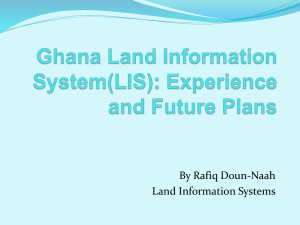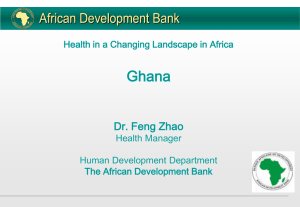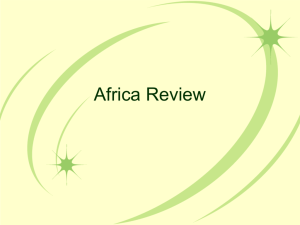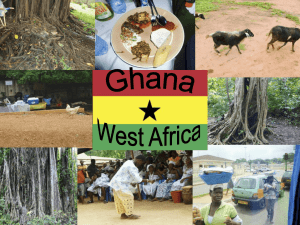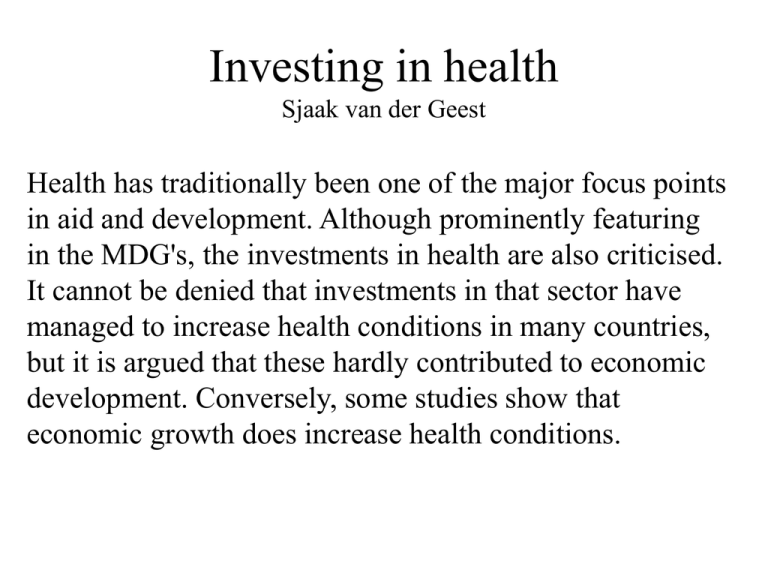
Investing in health
Sjaak van der Geest
Health has traditionally been one of the major focus points
in aid and development. Although prominently featuring
in the MDG's, the investments in health are also criticised.
It cannot be denied that investments in that sector have
managed to increase health conditions in many countries,
but it is argued that these hardly contributed to economic
development. Conversely, some studies show that
economic growth does increase health conditions.
If we are trying to look for causes of the
differences in progress between sub-Saharan
Africa and Asia, the low level of social
development in health and education is the first
cause that springs to mind. (from: Doing good or
doing better)
Poor countries account for 56 percent of the global
disease burden but less than 2 percent of global
health spending. With the global commitment to the
Millennium Development Goals in 2000, poverty and
the deplorable health conditions of the world's poor
have finally reached center stage in the international
policy arena, and aid for health has greatly increased.
(From abstract: Schieber et al.
2007 Financing Global Health: Mission Unaccomplished.
Health Affairs 26 (4): 921–934)
Billions of dollars in aid are given every year to improve the
health of the world's poor, and yet preventable diseases such as
diarrhea and malaria continue to kill a child every thirty
seconds and result in almost eleven million child deaths per
year in poor countries. Pregnancy and childbirth continue to be
a primary cause of death for women in developing countries,
killing more than 500,000 women every year. More than
twenty years into the AIDS pandemic, the disease is
continuing to spread; in 2006 AIDS killed almost three million
people, 380,000 of whom were under age fifteen.
Tuberculosis, outpacing the medicines that exist to treat it
killed 1.83 million people in 2006.
Opening paragraph : Schieber et al. (2007) Financing Global Health:
Mission Unaccomplished. Health Affairs 26 (4): 921–934
Development policy and health
• Urgency of health
• Its short-term character: attractive to donors
and politicians
• Health is an indicator of development
• Poor health is seen as an obstacle to
development
Cultural (medical) anthropology
• Descriptive / ethnography
• Understanding (cognitive, emotional,
moral)
• Reluctance to ‘explain’ / predict
• Approach: participant observation en
conversation
• Sharing experiences on ‘the ground’ makes
modest
Multi-level perspective
• Different levels, different cultures
(international; government; health service;
households)
• Conflicting interests between level
• Leads to conflictions ideas and actions
• Aim: understanding one level in the context
of other levels
• ‘Development interventionism’ (Verheijen)
Example 1:‘Unruly mélange’ (Buse &
Walt 1997)
• Ideas and objectives of donors and
‘recipients’ (= governments) may be
different / conflicting
• But what about ideas and objectives of govt,
vs those of health workers & households???
• Authors seem to assume that govts
represent the interests of these lower levels
Example 2: Monitoring use of essential
drugs
• Evaluation by WHO of the success of its
Essential Drugs Program (started in 1972)
• By reading policy documents of a number
of selected countries
• Assumption was that if govt mentions
‘essential drugs’, essential drugs are indeed
made available to patients.
Personal retrospect
• 1973. Birth control in Ghana
• 1980. Distribution and use of
pharmaceuticals in Cameroon
• 1994-today. Experiences of growing old in
Ghana (‘Money is man’)
• 1996-today. Sanitation and concepts of
hygiene in Ghana
Money and medicine(s) (Cameroon)
• Paying implies appreciation of the value of medicine (as in
‘traditional’ medicine)
• Free dispension of medicines may lead to the opposite
• Paying produces awareness of consumer rights
• Where health care & medicines are free, patients have little
leverage to address inefficiency or abuse (‘beggar has no
choice’)
• Health insurance should also make clients aware of their
rights
Nine stories of students’ research
•
•
•
•
•
•
•
•
•
Francine van den Borne (Malawi)
Getnet Tadele (Ethiopia)
Esther Wiegers (Zambia)
Jonathan Dapaah & Benjamin Kwansa (Ghana)
Benson Mulemi (Kenya)
Judith van de Kamp (Ghana)
Agnes Kotoh (Ghana)
Magi Matinga (South Africa)
Janneke Verheijen(Malawi)
Francine van den Borne (2005) Trying to survive in
times of poverty and AIDS: Women and multiple
partner sex in Malawi. Amsterdam: Het Spinhuis.
•
•
•
•
•
•
Mystery client approach
Poor women look for a male helper
To feed their families
Risking their own lives
Gender inequality
Poverty leads to hazardous sex (and HIV/AIDS)
Getnet Tadele (2005) Bleak prospects: Young men,
sexuality and HIV/AIDS in an Ethiopian town.
Leiden: African Studies Centre.
• Male youngsters between 15 – 24
• Perceptions and practices love and sex (‘girls
want money’)
• Within a broad social context (poverty, social
exclusion, police harassment)
• Youngsters more concerned about day-to-day
survival than HIV/AIDS
• Author’s pessimism regarding ‘solutions’ (p. 171)
Esther Wiegers (2008) Resilience and AIDS.
Exploring resilience in the case of AIDS among
female-headed households in Northern Zambia.
Medische Antropologie 20 (2): 259-278.
• What is resilience?
• Some ‘bounce back’, some don’t (4 narratives)
• Why? Economic independence, social network,
access to ART, health insurance, marriage system.
• Some engage in transactional sex (cf. Van den
Borne)
• Emotional / psychological dimension of resilience.
Jonathan Dapaah & Benjamin Kwansa: PLWA in
the community and in the hospital (Ghana). In
progress
• Two-level study: hospital / community
• Role of stigma: social consequences of revealing
HIV are worse than the sickness
• ART is available but many refuse treatment for
fear of stigmatization
• PLWA find a new ‘family’ in hospital
• PLWA want to be peer supporters (also
counselling) but their experience expertise is
under-valued (cf. Kober & Van Damme 2006)
Benson A. Mulemi (2010) Coping with cancer and
adversity: Hospital ethnography in Kenya.
Leiden: African Studies Centre.
• Next to hospital and treatment costs patients
are worried about ‘additional bagage’
(family’s livelihood)
• Enormous social distance between doctors
and patients
• Hospital is a place of hope and despair
(collaps of health and livelihood)
Judith van de Kamp (2008) Aanpakken en
wegwezen: Een antropologisch onderzoek naar de
kortstondige inzet van gezondheidswerkers in
ontwikkelingslanden. Master Thesis, UvA (text on
line). See for English summary: Asking thém: Ghanaian
health workers about Dutch short-term health workers in
Ghanaian hospitals. Medicus Tropicus 50 -2: 6-7. (2008)
• Studied three categories of people involved in Dutch shortterm health work in Ghana (long-term workers; short-term
workers; local hospital staff)
• Debate in Dutch media
• Well-meant assistance was regarded as harmful by other
parties
• Ironic example of counterproductive health development
aid
Agnes Kotoh: Reaching the poor in health
insurance (Ghana), in progress
• How to include poor people in health insurance?
• Coverage is poor (ca 30% on average) in spite of
low premium (10 USD)
• Common & covenient excuse: we have no money
• But they do spend large amounts on funerals
• More social and cultural pressure on funeral
‘insurance’ than on health insurance
• Some people prefer to pay cash to get better health
care
Magi N. Matinga (2008) The making of hardiness in
women’s experience of health impacts of wood
collection and use in Cuntwini, rural South Africa.
Medische Antropologie 20 (2): 297-311.
• Wood collection causes health problems (back pains, etc)
• Cooking on wood fire causes health problems (eyes,
breathing, headache)
• Not simply result of poverty, even those who have
electricity may continue to collect wood
• Culture perpetuates unhealthy practices
• Wood collection shows the good quality of a woman
(hardiness)
Janneke Verheijen: Impact of food insecurity and
female empowerment efforts on risky sexual
behaviour in rural Malawi. In progress
• Assumption was: economic independence
prevents women from risky sexual relations (cf.
Verheijen 2007; Van den Borne; Wiegers)
• But: society does not allow a woman to remain
unmarried (risk for married women)
• Economics is not sufficient condition for
HIV/AIDS prevention
Tentative conclusions (1)
• Complexity and contradictions raise doubt about
clear recommendations
• To evaluate health development we need to study
all its organizational levels
• Economic problems and health problems are
intertwined.
• 80% of child mortality is due to nutrition (WHO),
so obviously agricultural and economic
investment is a must.
Tentative conclusions (2)
• Economic development improves conditions for
healthier living (but not always)
• Economic development improves coverage of
health insurance (but not always)
• Economic development improves access to and
use of health care (agency, consumer awareness,
ability to pay)
• Free health care may not lead to better health
(care)




